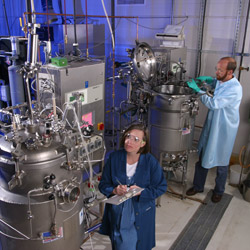Good Guys Vs. Bad Guys

A green field of wheat swaying in the wind as far as the eye can see is a pleasing sight for farmer and consumer alike. It represents the nearly fulfilled potential of a fine harvest to the farmer and, whether the consumer stops to consider it or not, the security of bread and other wheat-based products for their table in the coming months.
More often than not, however, an invader is lurking in the soil, on crop debris, even arriving by air from distant fields, waiting for warm, moist conditions that will allow it to attack and, in a matter of days, change the lush green heads into blighted, prematurely white heads. The damage this invader can cause to wheat heads is multifold and includes reduced yields; discolored, shriveled “tombstone” kernels; mycotoxin contamination that may be hazardous to human and animals who eat the kernels, and a reduction in seed quality. The result is that a crop with once high-potential value becomes one that will be difficult or impossible to market, export and/or process.
The invader is a fungus named Fusarium graminearum that infects wheat heads and causes the disease Fusarium head blight, or scab of wheat. It is documented as causing epidemics in 26 states and Canada, with losses to U.S. agriculture estimated at more than $2.6 billion in the 1990s alone. Since 1993, new research dollars have resulted in advances in controlling Fusarium head blight, including scab-tolerant wheat cultivars, planting alternative crops, increasing tillage, and applying fungicides in a timely and strategic manner. Yet each of these methods for reducing scab provides only incomplete control of the disease.
Biological control has potential as a new method to use alongside these traditional control measures or as a stand-alone treatment. In research conducted by scientists at the USDA-ARS National Center for Agricultural Utilization Research (NCAUR) in Peoria, naturally occurring bacteria and yeasts were isolated from wheat anthers, the pollen-making part of a wheat head. The scientists determined that a high percentage of these bacteria and yeasts were experts at using many of the same nutrients that the wheat scab fungus would normally use prior to infecting the wheat head. One yeast discovered among these strains apparently uses the nutrients on wheat heads so quickly that the scab fungus has little success in causing infection.
By conducting multiple investigations on how to mass-produce this naturally occurring yeast, NCAUR researchers have developed a yeast-based formulation. Used in field trials conducted across several states, this formulation has shown great potential to reduce both the amount of disease and the mycotoxin produced by the pathogen. Combining this yeast treatment with a fungicide approved for use against scab could result in even better scab control by providing a “one-two” punch that would slow the infection in two different ways.
However, the biocontrol yeast is also a type of fungus, and so fungicides that can slow the scab fungus can also adversely affect the yeast, reducing its effectiveness against the pathogen. Recent research by NCAUR scientists has shown that growing the yeast biocontrol agent in liquid broths containing low concentrations of the fungicide can result in the yeast becoming more tolerant of the fungicide. While there is no guarantee that variants of the biocontrol yeast will be found that are completely resistant, results indicate that the yeast now tolerates higher fungicide concentrations than those used in initial experiments and is even more effective in slowing the pathogen.
A commercial partner is assisting in the process of transforming this technology into a commercially available product. It is expected that this new tool for reducing scab of wheat will be available to agricultural producers in the near future, and its use will contribute to enhancing the security of the United States’ wheat-based food supply. As with so many technologies beginning with a focus on U.S. agriculture, the ultimate impact of this research will benefit crop production around the world. iBi
David Schisler is a research plant pathologist in the Crop Bioprotection Research Unit at the USDA ARS National Center for Agricultural Utilization Research in Peoria.

